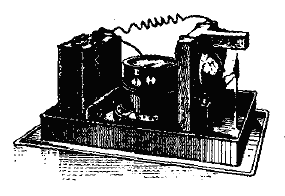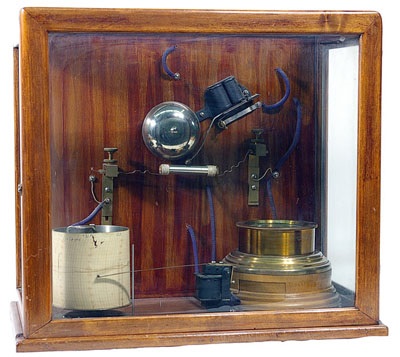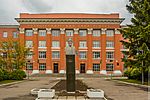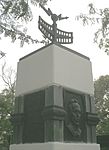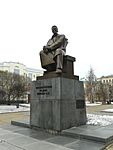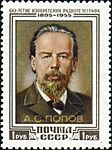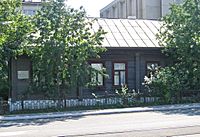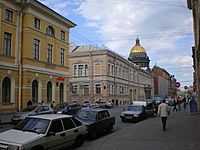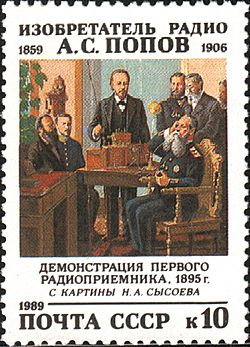Alexander Stepanovich Popov facts for kids
Quick facts for kids
Alexander Stepanovich Popov
|
|
|---|---|
 |
|
| Born | 16 March 1859 Turyinskiye Rudniki settlement, Perm Governorate, Russian Empire
|
| Died | 13 January 1906 (aged 46) St. Petersburg, Russian Empire
|
| Known for | Radio |
| Awards | Order of St. Anna of 3rd and 2nd grades Order of Saint Stanislaus (Imperial House of Romanov) of 2nd grade Silver medal of Alexander III reign honour on the belt of Order of Alexander Nevsky Prize of Imperial Russian Technical Society |
| Signature | |
Alexander Stepanovich Popov (born March 16, 1859 – died January 13, 1906) was a Russian physicist. He was one of the first people to invent a device that could receive radio signals.
Popov worked as a teacher at a Russian naval school. This job led him to study how high-frequency electricity works. On May 7, 1895, he showed off a wireless lightning detector he had built. This device used a special part called a coherer to find radio noise from lightning. This day is now celebrated in Russia as Radio Day. On March 24, 1896, he showed that he could send radio signals 250 meters (about 820 feet) between buildings in St. Petersburg. His work was similar to what Guglielmo Marconi was doing at the same time.
Contents
Early Life and Education
Alexander Popov was born in a town called Krasnoturinsk in the Urals. His father was a priest. From a young age, Alexander was very interested in science. His father wanted him to become a priest too. So, he sent Alexander to a seminary school in Yekaterinburg.
But Alexander became more interested in science and math. In 1877, instead of going to theology school, he went to St. Petersburg University to study physics. He graduated with high honors in 1882 and stayed on as a lab assistant. However, the pay was not enough to support his family. So, in 1883, he became a teacher and lab head at the Russian Navy's Torpedo School in Kronstadt.
How Popov's Radio Receiver Worked
While teaching at the naval school, Popov also did his own research. He was trying to solve a problem with electrical wires on steel ships. This led him to study high-frequency electrical currents and oscillations. His interest in these "Hertzian" or radio waves grew after a trip to the Chicago World's Columbian Exposition in the United States in 1893. There, he met other scientists working in the same field.
Popov also read an article from 1894 about experiments by British physicist Oliver Lodge. Lodge's work was related to the discovery of radio waves by German physicist Heinrich Hertz six years earlier. Lodge had shown how radio waves could be sent up to 50 meters (about 164 feet). He used a detector called a coherer. This was a glass tube with metal filings inside. When radio waves hit the coherer, the metal filings would stick together, allowing electricity to flow through. After a signal, the filings needed to be reset, usually by shaking the tube.
Popov decided to build a more sensitive radio wave receiver. He wanted to use it as a lightning detector. This device would warn of thunderstorms by sensing the electromagnetic pulses from lightning strikes.
Operating Principle of the Detector
In Popov's lightning detector, the coherer (marked C) was connected to an antenna (A) and to a separate circuit. This circuit had a relay (R) and a battery (V) that powered an electric bell (B). When lightning struck, it created radio noise. This noise made the coherer turn on. Then, electricity from the battery flowed to the relay, which closed its contacts. This sent power to the electromagnet (E) of the bell, making it ring.
Popov added a clever feature: an automatic reset. When the bell rang, its arm would spring back and tap the coherer. This tap would reset the metal filings, making the coherer ready to receive the next signal. Two special parts called chokes (L) stopped the radio signal from going through the DC circuit instead of the coherer. He connected his receiver to a wire antenna (A) high in the air and to the ground (G). This antenna was an early version of a monopole wire antenna.
Early Demonstrations
On May 7, 1895, Popov presented his paper "On the Relation of Metallic Powders to Electric Oscillations" to a scientific group in St. Petersburg. This paper described his lightning detector. Many Eastern countries consider Popov's lightning detector to be the first radio receiver. Because of this, May 7 has been celebrated as "Radio Day" in Russia since 1945. However, there is no proof that Popov sent any messages during this first demonstration.
The first time Popov was known to use his device for communication was on March 24, 1896. During a demonstration, some reports say the Morse code message "ГЕНРИХ ГЕРЦ" ("HEINRICH HERTZ" in Russian) was received. This message came from a transmitter 250 meters (about 820 feet) away and was written on a blackboard.
Around the same time, in 1895, Italian inventor Guglielmo Marconi also began working on a wireless telegraphy system. He developed a spark-gap transmitter and a much better coherer receiver that reset itself automatically. By mid-1895, Marconi had sent messages half a mile (800 meters). He then realized that grounding both his transmitter and receiver helped. By mid-1896, he was sending radio messages a mile and a half (2400 meters). It seems Popov and Marconi worked on their early systems without knowing about each other's progress. However, after reading about Marconi's work, Popov also started developing a long-range wireless telegraphy system.
Popov's paper about his experiments was published on December 15, 1895. He did not apply for a patent for his invention. In July 1895, he put his receiver on the roof of the Institute of Forestry building in St. Petersburg. He was able to detect thunderstorms up to 50 kilometers (about 31 miles) away. He also understood that his device could be used for communication.
In 1896, an article about Popov's invention was reprinted. In March 1896, he successfully sent radio waves between different buildings on his campus in St. Petersburg. By 1898, a French businessman named Eugene Ducretet was making wireless telegraphy equipment based on Popov's ideas. Popov also achieved ship-to-shore communication over 6 miles (about 10 km) in 1898 and 30 miles (about 48 km) in 1899.
Later Work and Achievements
In 1900, a radio station was set up based on Popov's instructions on Hogland island. This station provided two-way wireless communication. It connected the Russian naval base with the battleship General-Admiral Apraksin. The battleship had run aground on Hogland island in November 1899. The crew was not in immediate danger, but the sea began to freeze.
Because of bad weather and slow paperwork, the crew did not arrive until January 1900 to set up the wireless station. But by February 5, messages were being sent and received reliably. The wireless messages were sent to Hogland Island from a station about 25 miles (40 km) away in Kymi (now Kotka) on the Finnish coast. Kotka was chosen because it was the closest point to Hogland Island that had telegraph wires connected to the Russian naval headquarters.
By the time the Apraksin was freed by the icebreaker Yermak in April, the Hogland Island wireless station had handled 440 official telegraph messages. Besides helping the Apraksin crew, more than 50 Finnish fishermen were saved. They were stuck on a piece of drift ice in the Gulf of Finland. The icebreaker Yermak rescued them after distress messages were sent by wireless telegraphy.
In 1901, Alexander Popov became a professor at the Electrotechnical Institute. In 1905, he was chosen to be the director of the institute.
Death
In 1905, Alexander Popov became very ill. He died from a brain hemorrhage on January 13, 1906.
Honors and Legacy
Radio Day
In 1945, on the 50th anniversary of Popov's experiment, the old Soviet Union created a new holiday called Radio Day. They claimed this was the day Popov invented radio. This holiday is still celebrated in Russia and Bulgaria.
Named After Popov
A minor planet, 3074 Popov, was discovered in 1979 by Soviet astronomer Lyudmila Zhuravlyova. It was named after him. Also, a conference room at the International Telecommunication Union (ITU) headquarters in Geneva is named "Alexander Stepanovich Popov."
Monuments and Museums
Many monuments and museums honor Alexander Popov.
- A monument to A. S. Popov can be found in Nizhny Novgorod, at the Museum of Radiophysics.
- There is also a monument in Krasnoturinsk, his birthplace.
- The A.S. Popov Central Museum of Communications in Saint Petersburg is named after him.
- The House-Museum of Alexander Stepanovich Popov is in Krasnoturinsk.
-
100 years sign of radio in Sevastopol
-
Monument to Popov in Yekaterinburg city
Books and Films
- A book about him is "Alexander Stepanovich Popov" by G.I. Golovin.
- A movie called Alexander Popov (film) was made in 1949. It tells the story of his life and work.
Holidays and Coins
- March 16 is Alexander Popov's birthday.
- May 7 is Radio Day.
- In 1984, the USSR State Bank made a special coin with a value of 1 ruble to honor A.S. Popov.
- Many postage stamps have been issued showing A.S. Popov and honoring him as the inventor of radio.
Family
Some of Alexander Popov's family members moved to Manchuria during the Bolshevik Revolution. Later, they went to the United States. One of his cousins, Dr. Paul Popov, became a well-known doctor in San Francisco. Paul's son, Egor Popov (1913–2001), became a professor of Civil and Environmental Engineering at UC Berkeley.
See Also
 In Spanish: Aleksandr Stepánovich Popov para niños
In Spanish: Aleksandr Stepánovich Popov para niños
- All-Russia Exhibition 1896
- Invention of radio
- Radio Day


